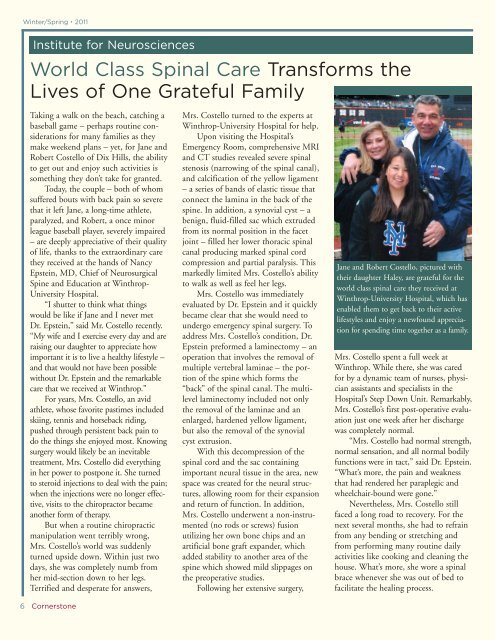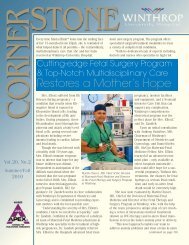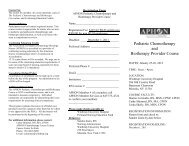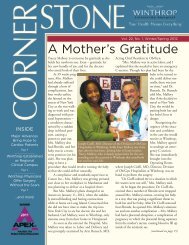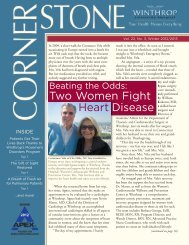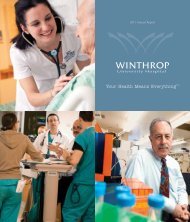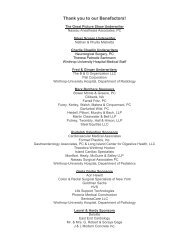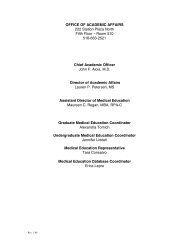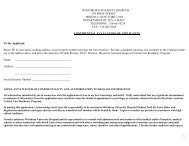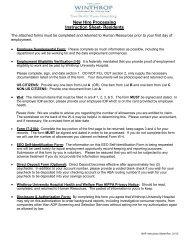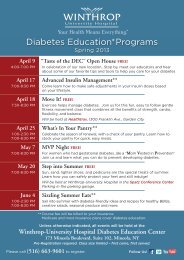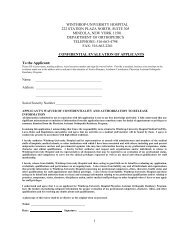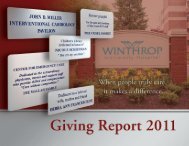Fourth Chance at Life - Winthrop University Hospital
Fourth Chance at Life - Winthrop University Hospital
Fourth Chance at Life - Winthrop University Hospital
- No tags were found...
You also want an ePaper? Increase the reach of your titles
YUMPU automatically turns print PDFs into web optimized ePapers that Google loves.
Winter/Spring • 2011Institute for NeurosciencesWorld Class Spinal Care Transforms theLives of One Gr<strong>at</strong>eful FamilyTaking a walk on the beach, c<strong>at</strong>ching abaseball game – perhaps routine consider<strong>at</strong>ionsfor many families as theymake weekend plans – yet, for Jane andRobert Costello of Dix Hills, the abilityto get out and enjoy such activities issomething they don’t take for granted.Today, the couple – both of whomsuffered bouts with back pain so severeth<strong>at</strong> it left Jane, a long-time <strong>at</strong>hlete,paralyzed, and Robert, a once minorleague baseball player, severely impaired– are deeply appreci<strong>at</strong>ive of their qualityof life, thanks to the extraordinary carethey received <strong>at</strong> the hands of NancyEpstein, MD, Chief of NeurosurgicalSpine and Educ<strong>at</strong>ion <strong>at</strong> <strong>Winthrop</strong>-<strong>University</strong> <strong>Hospital</strong>.“I shutter to think wh<strong>at</strong> thingswould be like if Jane and I never metDr. Epstein,” said Mr. Costello recently.“My wife and I exercise every day and areraising our daughter to appreci<strong>at</strong>e howimportant it is to live a healthy lifestyle –and th<strong>at</strong> would not have been possiblewithout Dr. Epstein and the remarkablecare th<strong>at</strong> we received <strong>at</strong> <strong>Winthrop</strong>.”For years, Mrs. Costello, an avid<strong>at</strong>hlete, whose favorite pastimes includedskiing, tennis and horseback riding,pushed through persistent back pain todo the things she enjoyed most. Knowingsurgery would likely be an inevitabletre<strong>at</strong>ment, Mrs. Costello did everythingin her power to postpone it. She turnedto steroid injections to deal with the pain;when the injections were no longer effective,visits to the chiropractor becameanother form of therapy.But when a routine chiropracticmanipul<strong>at</strong>ion went terribly wrong,Mrs. Costello’s world was suddenlyturned upside down. Within just twodays, she was completely numb fromher mid-section down to her legs.Terrified and desper<strong>at</strong>e for answers,Mrs. Costello turned to the experts <strong>at</strong><strong>Winthrop</strong>-<strong>University</strong> <strong>Hospital</strong> for help.Upon visiting the <strong>Hospital</strong>’sEmergency Room, comprehensive MRIand CT studies revealed severe spinalstenosis (narrowing of the spinal canal),and calcific<strong>at</strong>ion of the yellow ligament– a series of bands of elastic tissue th<strong>at</strong>connect the lamina in the back of thespine. In addition, a synovial cyst – abenign, fluid-filled sac which extrudedfrom its normal position in the facetjoint – filled her lower thoracic spinalcanal producing marked spinal cordcompression and partial paralysis. Thismarkedly limited Mrs. Costello’s abilityto walk as well as feel her legs.Mrs. Costello was immedi<strong>at</strong>elyevalu<strong>at</strong>ed by Dr. Epstein and it quicklybecame clear th<strong>at</strong> she would need toundergo emergency spinal surgery. Toaddress Mrs. Costello’s condition, Dr.Epstein preformed a laminectomy – anoper<strong>at</strong>ion th<strong>at</strong> involves the removal ofmultiple vertebral laminae – the portionof the spine which forms the“back” of the spinal canal. The multilevellaminectomy included not onlythe removal of the laminae and anenlarged, hardened yellow ligament,but also the removal of the synovialcyst extrusion.With this decompression of thespinal cord and the sac containingimportant neural tissue in the area, newspace was cre<strong>at</strong>ed for the neural structures,allowing room for their expansionand return of function. In addition,Mrs. Costello underwent a non-instrumented(no rods or screws) fusionutilizing her own bone chips and anartificial bone graft expander, whichadded stability to another area of thespine which showed mild slippages onthe preoper<strong>at</strong>ive studies.Following her extensive surgery,Jane and Robert Costello, pictured withtheir daughter Haley, are gr<strong>at</strong>eful for theworld class spinal care they received <strong>at</strong><strong>Winthrop</strong>-<strong>University</strong> <strong>Hospital</strong>, which hasenabled them to get back to their activelifestyles and enjoy a newfound appreci<strong>at</strong>ionfor spending time together as a family.Mrs. Costello spent a full week <strong>at</strong><strong>Winthrop</strong>. While there, she was caredfor by a dynamic team of nurses, physicianassistants and specialists in the<strong>Hospital</strong>’s Step Down Unit. Remarkably,Mrs. Costello’s first post-oper<strong>at</strong>ive evalu<strong>at</strong>ionjust one week after her dischargewas completely normal.“Mrs. Costello had normal strength,normal sens<strong>at</strong>ion, and all normal bodilyfunctions were in tact,” said Dr. Epstein.“Wh<strong>at</strong>’s more, the pain and weaknessth<strong>at</strong> had rendered her paraplegic andwheelchair-bound were gone.”Nevertheless, Mrs. Costello stillfaced a long road to recovery. For thenext several months, she had to refrainfrom any bending or stretching andfrom performing many routine dailyactivities like cooking and cleaning thehouse. Wh<strong>at</strong>’s more, she wore a spinalbrace whenever she was out of bed tofacilit<strong>at</strong>e the healing process.6Cornerstone


